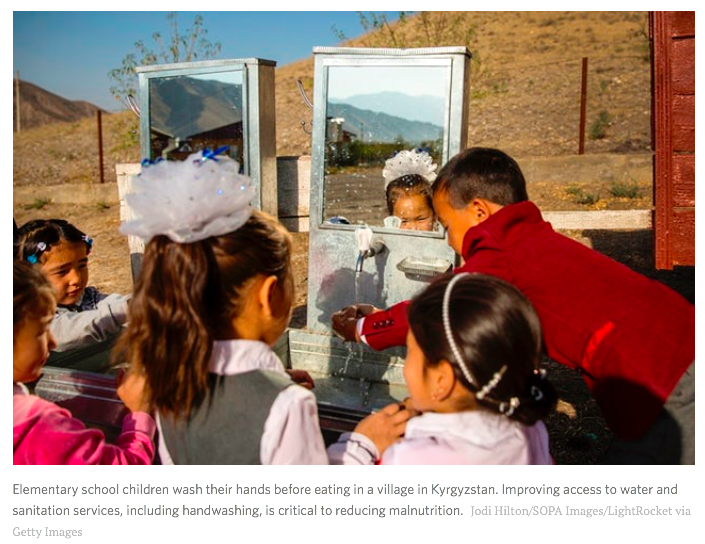Nutrition Interventions Alone Not Enough to Reduce Stunting: New Report
 A new analysis from nonprofits WaterAid and PATH calls for collaborative approaches across the health, nutrition and water and sanitation sectors.
A new analysis from nonprofits WaterAid and PATH calls for collaborative approaches across the health, nutrition and water and sanitation sectors.
ACHIEVING MAJOR REDUCTIONS in stunting may hinge not only on improved access to food, but on integrating programs to improve nutrition with efforts to increase access water, sanitation and hygiene (WASH) services and to healthcare.
A new analysis from the international nonprofits PATH – through its Defeat Diarrheal Diseases initiative – and WaterAid underscores the importance of linking these programs, while providing a roadmap for countries looking to better coordinate these efforts.
Helen Hamilton, WaterAid’s senior policy analyst for health and hygiene, spoke to Malnutrition Deeply about this strategy, which calls for improving coordination across relevant ministries, integrating critical programs and drawing domestic and international investments to support the efforts.
Malnutrition Deeply: What motivated the release of this report?
Helen Hamilton: We know that the foundations for healthy childhood really include clean water, decent toilets and good hygiene. And those need to be combined with immunization and good nutrition. Far too many children are deprived of these components, which affects their health, their education and ultimately their life chances.
The reason for launching this report was really that our modeling showed that if every child in the world had access to clean water, decent toilets and good hygiene, including the handwashing with soap component, alongside routine rotavirus immunization and other nutritional interventions, we could cut the rate of death from pneumonia and diarrhea by half. And that’s almost 700,000 children under 5 who could potentially be saved each year.
It requires coordinating those components and for investment in health, nutrition and WASH. And we know the U.N. [Sustainable Development Goal] 6 around water and sanitation for everyone, everywhere by 2030 is one of the goals that’s under review in New York in July. We’re calling on decision-makers to make [WASH] a priority because without it all the goals on health and nutrition aren’t going to be met.
Malnutrition Deeply: Can you talk more specifically about the potential impact this approach could have on stunting?
Hamilton: So often when we talk about malnutrition, it’s nearly always a focus on the lack of food, or the wrong types of food. And I think to date the effect of WASH on nutrition has been given sort of comparatively low priority. And we know that half of all undernutrition is estimated to be associated with repeated diarrhea, intestinal worms and other infections, which is a direct consequence of inadequate access to WASH.
A couple of years ago there was research which estimated that direct interventions to address malnutrition, such as nutrient supplements or the exclusive breast-feeding components, can only reduce stunting by 20 percent in the worst-affected countries, even if they’re reaching 90 percent of the population in need.
So that means [improving] access to clean water, sanitation and hygiene along with these other measures in the different sectors plays a crucial part in reducing the remaining 80 percent of stunting.
Malnutrition Deeply: There’s been a lot of discussion at the international level about multisectoral approaches, but how do you see that translating into national policy discussions?
Hamilton: The case and the motivation for this integration is clear. The question that we often focus on is, OK so how do you do it? What does that actually mean when people go back to their desks in the ministry of health, or as a program manager? What does it actually mean that you’ll be doing on a day-to-day basis?
For WaterAid, I think Madagascar is a really good example of a country that really sort of struggles, with almost half the people who live in the country lacking access to safe drinking water, and access to improved latrines is only about 12 percent. And waste management is really poorly developed. But the Madagascar government is strengthening coordination of efforts on malnutrition.
What we’ve seen is that plan is really taking a multistakeholder and multisector approach to accelerating reductions of stunting in children under 5. It’s aiming to decrease it from 47 percent to 38 percent by 2020. And it’s prioritizing nutrition-sensitive – as well as nutrition-specific – interventions, with targets to improve access to drinking water to 65 percent of households and sanitation to 30 percent by 2020. And promoting good food and hand hygiene.
So pulling all of those pieces together they’re strengthening, at this top level, the policy and regulatory environment governing nutrition. They’re improving those coordination mechanisms, and aligning action around this common result framework.
And then they’re putting more internal funding and directing external resources into this plan, then having practical things like multistakeholder consultations on nutrition and WASH. So, for me, that really highlights some of the success factors that you need in place in order to do well on it.
It is about really stopping that siloed ministry action. It’s sitting down in different ministries and moving away from that vertical approach.
But the responsibility is also on donating agencies, NGOs and U.N. agencies that can easily fall into, or have been falling into, the same trap of concentrating on their specific area and not collaborating. Data and information sharing is such a crucial element of how we bring this together. How are you using, for example, health data to target your WASH interventions? I think things like that can really help bring these different players together, alongside the joint policymaking and coordinated planning.
By: Andrew Green









